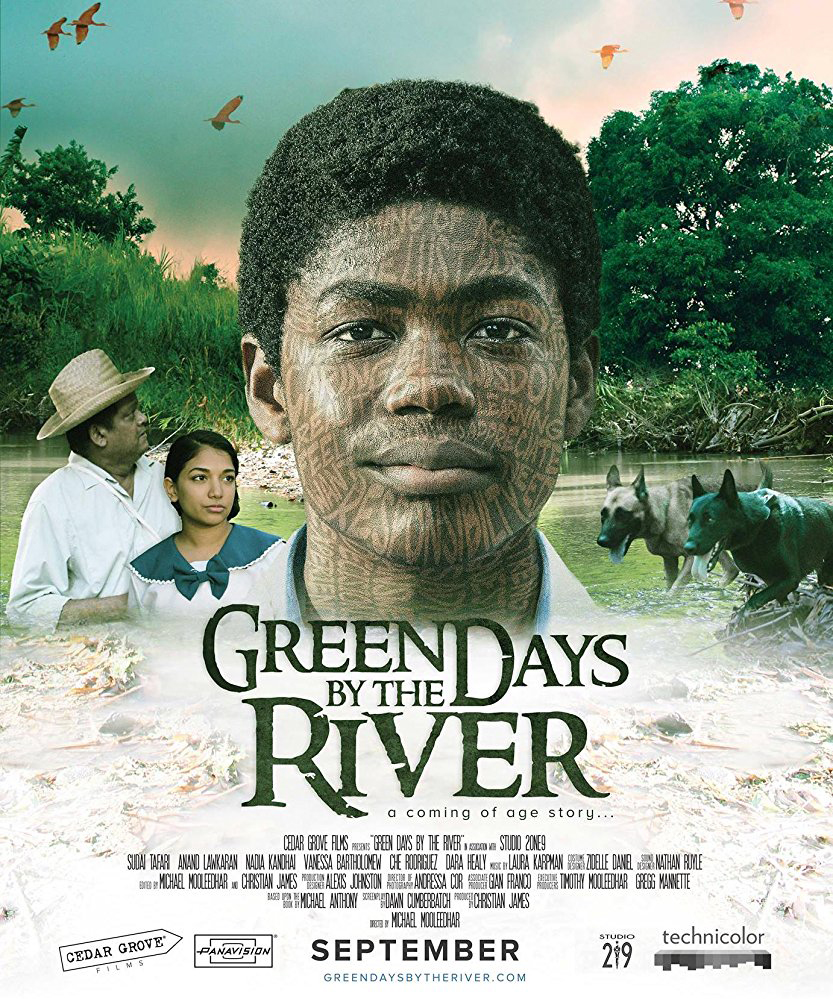 As much as Michael Anthony’s “Green Days by the River” has turned into a symbolic text of colonial life in Trinidad and Tobago, the story will always depend more on its value as a coming-of-age tale more than anything else. The crux of the story is straightforward. An impressionable teenage boy has a dying father and finds a masculine hero in the neighbouring land-owner, who has a daughter all the boys lust after. Things get complicated when the coquettishness of the girl next door becomes less attractive than the forthrightness of the new girl from the city and it all becomes more complicated when the adults get involved.
As much as Michael Anthony’s “Green Days by the River” has turned into a symbolic text of colonial life in Trinidad and Tobago, the story will always depend more on its value as a coming-of-age tale more than anything else. The crux of the story is straightforward. An impressionable teenage boy has a dying father and finds a masculine hero in the neighbouring land-owner, who has a daughter all the boys lust after. Things get complicated when the coquettishness of the girl next door becomes less attractive than the forthrightness of the new girl from the city and it all becomes more complicated when the adults get involved.
This is a very specific tale of a very specific boy living in a very specific time. The potentially universal aspects of the story (struggles with masculinity, teenage love, and teenage betrayal) are all specific because of the way it all depends on the specificity of its protagonist, Shellie Lammy. It’s why Anthony’s novel depends so much on the narrative structure of the tale told through its protagonist’s murky memories. The promise of a Trinidadian adaptation of this Trinidadian tale was good news, but I wondered how the idiosyncratic voice of the tale’s text would be or could be translated for film. Director Michael Mooleedhar’s film (written by Dawn Cumberbatch) nixes the obvious translation of Shell’s voice on the page to one of voice-over narration. At only 100 minutes, the film instead front-loads itself with montages to depict mid-20th century Mayaro as a place that becomes a crucible for Shellie.
 Sudai Tafari, cast as Shellie, carries a great weight on his shoulders. And for a film with much to be grateful about, my favourite realisation when it ended was that his performance (sometimes through the sheer emotiveness of his eyes) achieves something essential–that Shellie is always the most compelling figure on screen. Comparing Tafari’s performance to Ansel Elgort in last year’s “Baby Driver” might seem like damning with faint praise, but like Elgort, Tafari captures, so excellently, the almost charming indolence of a boy on the cusp of manhood without appearing sluggish on screen. The camera is compelled by him, and we are too. Shell, on his own, is not particularly interesting. His story is one of things happening to him rather than him doing things. Mooleedhar manages to avoid stagnation by depending so much on the montage to tell his story, and he’s lucky that Tafari is on hand to make those essential shots of Shell work. It’s the sort of essential gradation needed for the film to be effective and “Green Days by the River,” in an almost paradoxical bit of ingenuity, seems to work best when it is silent. Not what you would expect of a literary adaptation. It makes sense, though, because this Shell–freed from the burden of telling his story, unlike the Shell on the page–is free to navigate between the laconic style of a teenage boy and the occasional garrulousness of a teenage boy in love. Or in lust.
Sudai Tafari, cast as Shellie, carries a great weight on his shoulders. And for a film with much to be grateful about, my favourite realisation when it ended was that his performance (sometimes through the sheer emotiveness of his eyes) achieves something essential–that Shellie is always the most compelling figure on screen. Comparing Tafari’s performance to Ansel Elgort in last year’s “Baby Driver” might seem like damning with faint praise, but like Elgort, Tafari captures, so excellently, the almost charming indolence of a boy on the cusp of manhood without appearing sluggish on screen. The camera is compelled by him, and we are too. Shell, on his own, is not particularly interesting. His story is one of things happening to him rather than him doing things. Mooleedhar manages to avoid stagnation by depending so much on the montage to tell his story, and he’s lucky that Tafari is on hand to make those essential shots of Shell work. It’s the sort of essential gradation needed for the film to be effective and “Green Days by the River,” in an almost paradoxical bit of ingenuity, seems to work best when it is silent. Not what you would expect of a literary adaptation. It makes sense, though, because this Shell–freed from the burden of telling his story, unlike the Shell on the page–is free to navigate between the laconic style of a teenage boy and the occasional garrulousness of a teenage boy in love. Or in lust.
Your mileage may vary, but the fact that his dual romantic relationships both seem too quick to be deep becomes a boon rather than a curse. Shell is too unformed to be certain of his feelings and the rapidity with which the film seems to thrust him into romance seems more an effective commentary on teenagers than the film. Mooleedhar’s camera is more confident in the scenes that are less dependent on dialogue. The film, in some extended wordy scenes, seems to stall when it should propel forward. Shellie’s relationship with the land-owner Gidharee, for all the talk of romance, is the most essential relationship of the story. The film depends on Mr Gidharee’s successful wooing of Shell as a potential son-in-law. Anand Lawkaran, who portrays the character, is clearly aware of the magnitude of his role and attacks it with gusto but the chemistry between him and Tafari is the film’s only real threat of liability. His Gidharee’s jocularity comes across as too deliberate to be natural, and too forced to be charming. Of course this reading, then, changes the course of the story in a way that hardens the tough themes later on in the film. Moreover, it hardly destroys the film, which emerges as an essential beacon in 21st century filmmaking in the region.
There is a scene midway through “Green Days by the River” where the narrative pauses for an extended musical break. Musical instruments and a mournful song seep through the narrative to present a montage of a day in the life of a cocoa worker in 1950s Trinidad. It’s the surest scene of the film visually, which becomes ironic for how little the narrative needs but conversely how much the film benefits from it. It’s an excellent rendering of the kind of filmmaker Mooleedhar can be. I’d like to see Mooleedhar tackle something in the vein of a “Tree of Life” or “English Patient,” where the terrain becomes the protagonist. And, it’s a great credit that his film never feels buckled by its source.
There’s a beautiful shot of Tafari’s face a few moments before the end of the film. His expression is one of simultaneous bafflement and worry. The shot is so evocative, so right, that I wished heartily that it would have been the final shot of the movie. The actual final shot of the film when it does come, a tableau of Shell looking towards the future flanked by two key characters, feels too literal and on the nose and seems to turn his narrative from a specific internal one into one that argues for something more universal. I’m not sure if that take works. The specificity of Shell’s story is where either version of the text works. But that last shot is almost superfluous when Tafari’s expressive face throughout is telling us all we need to know. To come of age as a poor boy in colonial Trinidadian is a time that’s marked by confusion and consistent bafflement. I’m intrigued to see what Mooleedhar does next but my real interest after “Green Days by the River” is the hope that Sudai Tafari’s talent can be harnessed to make a career on screen.
“Green Days by the River” is currently playing at Caribbean Cinemas







